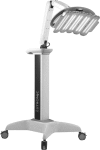Is light-emitting diode phototherapy (LED-LLLT) really effective?
- PMID: 24155530
- PMCID: PMC3799034
- DOI: 10.5978/islsm.20.205
Is light-emitting diode phototherapy (LED-LLLT) really effective?
Abstract
Background: Low level light therapy (LLLT) has attracted attention in many clinical fields with a new generation of light-emitting diodes (LEDs) which can irradiate large targets. To pain control, the first main application of LLLT, have been added LED-LLLT in the accelerated healing of wounds, both traumatic and iatrogenic, inflammatory acne and the patient-driven application of skin rejuvenation. Rationale and Applications: The rationale behind LED-LLLT is underpinned by the reported efficacy of LED-LLLT at a cellular and subcellular level, particularly for the 633 nm and 830 nm wavelengths, and evidence for this is presented. Improved blood flow and neovascularization are associated with 830 nm. A large variety of cytokines, chemokines and macromolecules can be induced by LED phototherapy. Among the clinical applications, non-healing wounds can be healed through restoring the collagenesis/collagenase imbalance in such examples, and 'normal' wounds heal faster and better. Pain, including postoperative pain, postoperative edema and many types of inflammation can be significantly reduced. Experimental and clinical evidence: Some personal examples of evidence are offered by the first author, including controlled animal models demonstrating the systemic effect of 830 nm LED-LLLT on wound healing and on induced inflammation. Human patients are presented to illustrate the efficacy of LED phototherapy on treatment-resistant inflammatory disorders.
Conclusions: Provided an LED phototherapy system has the correct wavelength for the target cells, delivers an appropriate power density and an adequate energy density, then it will be at least partly, if not significantly, effective. The use of LED-LLLT as an adjunct to conventional surgical or nonsurgical indications is an even more exciting prospect. LED-LLLT is here to stay.
Keywords: Grotthus-Draper law; acne rosacea; dissecting cellulitis; irritant contact dermatitis; nonhealing wound; photochemical cascade; photophysical reaction.
Figures










References
-
- Ohshiro T, Calderhead RG: Low Level Laser Therapy: a Practical Introduction. 1988. John Wiley and Sons, Chichester, UK
-
- Mester E, Szende B, Spiry T, Scher A. (1972): Stimulation of wound healing by laser rays. Acta Chir Acad Sci Hung. Acta Chir Acad Sci Hung: 315–324 - PubMed
-
- Calderhead RG, Ohshiro T, Ito E, Okada T, Kato K: The Nd:YAG and GaAlAs lasers: a comparative analysis in pain therapy. In Atsumi K, Nimsakul N, Eds: Laser Tokyo ‘81. 1981, Japan Society for Laser Surgery and Medicine, Tokyo: Section 21, pp 1–4
-
- Whelan HT, Houle JM, Whelan NT. et al. (2000): The NASA Light-Emitting Diode Medical Program-Progress in Space Flight and Terrestrial Applications. Space Tech. & App. Int'l. Forum. Space Tech. & App. Int'l. Forum: 37–43
-
- Calderhead RG. (2007): The photobiological basics behind light-emitting diode (LED) phototherapy. Laser Therapy, 16: 97–108
Publication types
LinkOut - more resources
Full Text Sources
Other Literature Sources
